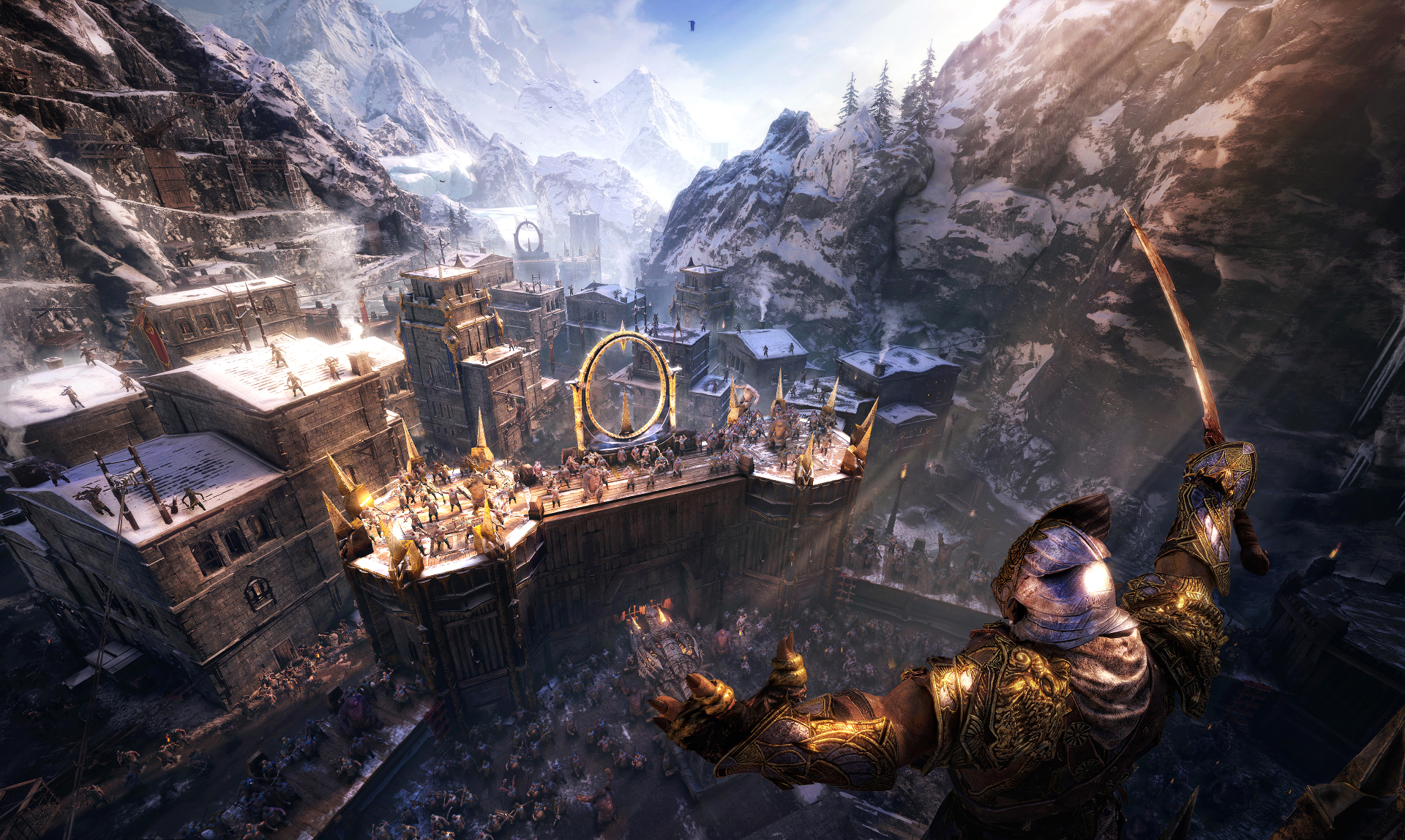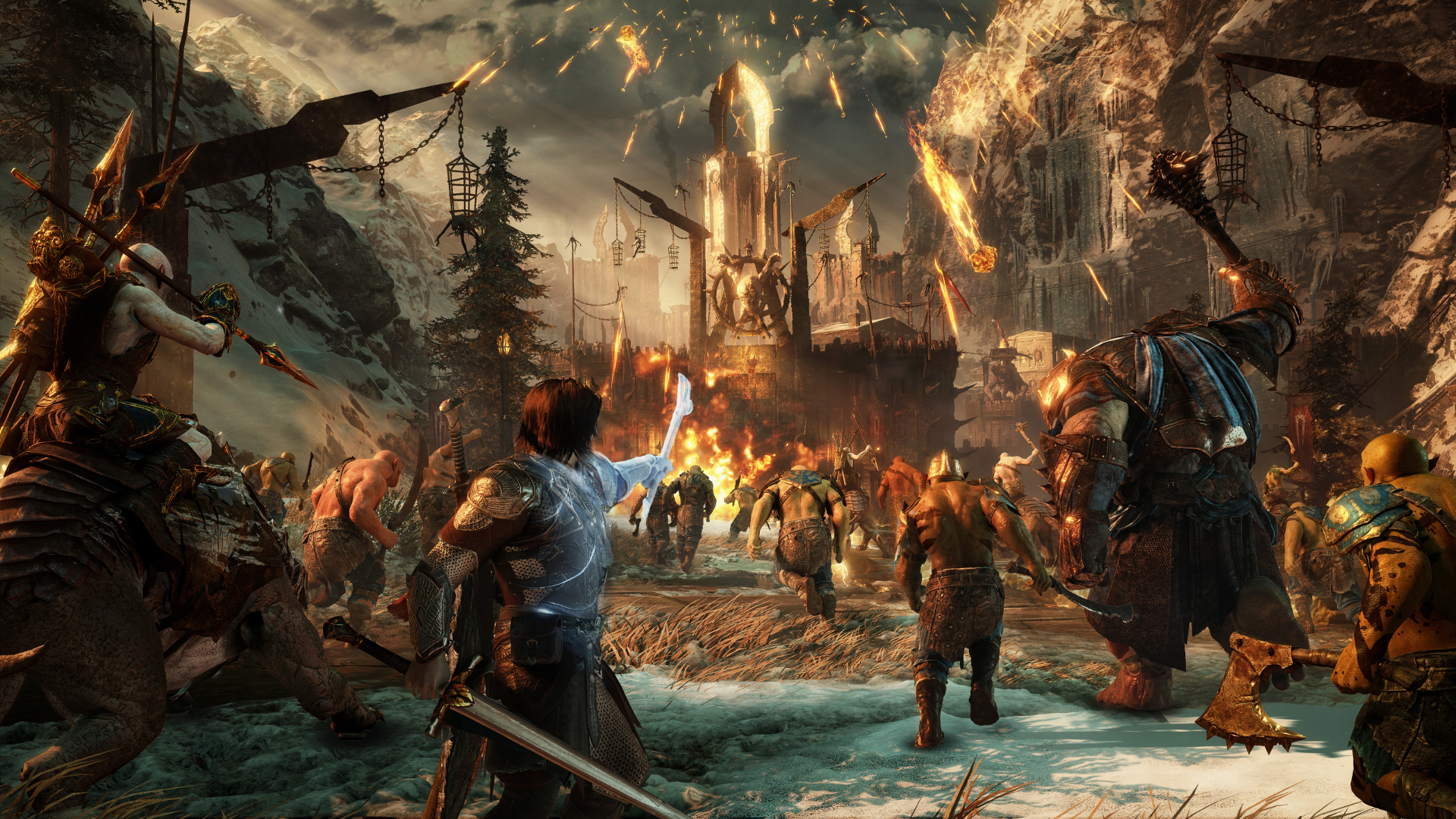Middle-Earth: Shadow of Mordor was a game about guerrilla warfare… and also falling in love with orcs. By contrast, this winter’s sequel, Middle-Earth: Shadow of War is a game about full-scale warfare… and also falling in love with orcs.
Shadow of War is a painfully generic subtitle, but there is a ring of truth to it. I got to see a demo of the game in action last week during GDC, and development studio Monolith wasted no time with small stuff. This one is all about armies. Assembling them; fighting them; telling them they are all very good, strong orc boys — those kinds of things. Your goal? To take back Mordor and territories beyond from Sauron’s forces.
Sauron, because he is extremely vain, has scarred the land with his unmistakable brand of jagged, impractical architecture, so you have your work cut out for you. Nemesis-System-powered overlords command fortresses, each of which are staffed by Nemesis-System-powered warchiefs (which were the highest rank of orc in the previous game) and hundreds of other orcs. The Nemesis System, for those who didn’t play the first game, was a much-praised scheme in which enemies who killed the player would rise in the hierarchy of the enemy forces and essentially become custom foes for your character.
Fortress assaults in the new game are the culmination of copious open-world sandbox shenanigans, so you can, say, covertly turn a warchief to your side and have him betray his former overlord BFF in the heat of a fortress battle, which is neat.
Unfortunately, Monolith didn’t show us any open-world mischief-making, opting instead to leap straight into a fortress takeover. Immediately, however, we got to see a cool example of the Nemesis System in action. As main character Talion and his orcs stormed the front gates, a powerful enemy orc called out, swearing vengeance. Apparently, this orc used to be part of Talion’s army, but he got left behind during a botched mission. Not only did he “die”, but he also got his feelings hurt! Oh, and Sauron pumped him full of dark magic, so he had a lot going on, you know?
This orc managed to corner Talion and start choking the life out of him, but then the Nemesis System kicked in again, this time with added friendship. One of Talion’s warchiefs, an archer orc named Mozu Deadeye, loosed an arrow in the nick of time, eliminating the traitorous orc in gruesome fashion. Then several different varieties of shit hit the fan all at once.
First, a clearly deranged dancing orc, upon witnessing the death of the orc Talion’s warchief killed, dumped oil on Talion’s frontline. Then he set everybody on fire. In retaliation, Talion freed a dragon from a cage, which he scaled and used his ghost elf powers to “dominate”. The result? A fully flyable dragon.
After soaring between buildings and lighting somewhere in the neighbourhood of a whole neighbourhood of orcs on fire, Talion flew his dragon into a cave troll. The dragon didn’t fare so well, but neither did the cave troll, and Talion was able to capitalise. He was then able to waltz into the fortress’ main keep, where he encountered its overlord.

Orcs aren’t the only Mordor denizens in positions of power this time around. This particular overlord was a gigantic troll, and a boss fight was clearly imminent. It was not, however, a canned showdown. This troll also had Nemesis characteristics, and he reacted to specific damage Talion caused to his fortress. He was especially upset that his dragon got fashioned into a designer handbag by a cave troll, something I think we can all identify with.
The overlord was multiple times Talion’s size, so the person controlling him chose to evade and fire arrows. In retaliation, the overlord physically picked up his own orcs and hurled them at Talion (let it never be said that the Mordor games lack a sense of humour — at least, not entirely). He also set giant grooves in the ground on fire, confining the area in which Talion could manoeuvre. Thing began to look pretty dire for our intrepid hero. At the last possible second, however, Talion gave a few of his own orcs the signal to intervene, distracting the overlord long enough for Talion to strike a decisive blow with his ghost elf powers. Mission accomplished.
At that point, our demonstrator was given the option to staff the newly overtaken fortress with his own orcs. Depending on who he picked, the fortress would change. He could also directly upgrade the fortress and install new defences. Sauron’s forces will try to retake fortresses when they’re feeling sufficiently bold, so you’ve always gotta be prepared.

The demo ended there, but I made sure to ask about upgrades to the Nemesis System, because that’s probably why you’re reading this, and I honestly can’t blame you. Here’s what I found out:
- In Shadow of Mordor, orcs didn’t really have much personality after you dominated them and turned them to your side. This time around, there’ll be a greater focus on a wide variety of orc interactions. Friendships can be just as powerful and lasting as rivalries. As we learned in the demo, however, you’ll probably want to be careful about betraying your big green battle buddies. Some of them will take it very personally.
- Orcs have relationships with each other, too. They can be rivals, or they can have blood brothers that they feel especially bonded to. They can also possess hates, fears and reactions not only to things like fire and poison — as they did in the first game — but also what happens to their master, their best friend, or you.
- Monolith is focusing on making individual orcs memorable in multiple ways. They’re focusing a lot on when and why orcs confront you. Visually, meanwhile, they’re expanding the possible palette of options significantly. For instance, where Shadow of Mordor might’ve given you an orc with basic facial scars, Shadow of War will give you one that has scars on his face and body, and also maybe he sustained serious burns, which means he’ll react strongly to fire. Instead of attacking you entirely at random, he’ll likely appear when there’s fire involved. Basically, Monolith is trying to make these player-created narratives flow more naturally while simultaneously expanding the ways in which they can occur.
- In Shadow of War, there are multiple orc tribes with different characteristics and specialties. For instance, the Feral Tribe specialises in hunting, trapping and using monsters in battle. Depending on which tribe an overlord orc belongs to, their fortress will be entirely different.
- Your orcs don’t always have to be by your side. You can even send them away to do missions, assassinations and things of the like.
- You won’t be able to dress up or customise your orcs. Reason being, Monolith wants orcs’ appearances to be representative of their stories, not your decisions in a menu.
Based on what I saw of Shadow of War, the game looks like a much larger-scale take on the systems-driven shenanigans of the first. I do worry that, with so many ally and enemy orcs in play, individual interactions might become less special, but I can’t say for sure at this point. I’m also concerned that the game could devolve into a cookie-cutter open-world affair where fortress assaults all kinda bleed together, but it sounds like the new and improved Nemesis System will help prevent that.
It remains to be seen how this patchwork quilt of systems old and new fits together, but the underlying ideas are exciting. Middle-Earth: Orcs Have Feelings 2 will be out in August.

Comments
8 responses to “Middle-Earth: Shadow Of War’s Nemesis System Is About Friends As Well As Foes”
The subtitle means that the games listed in alphabetical order will also be in chronological order?
FUCKING SOLD.
Holding out for that dark final chapter Shadow of Zanzibar.
Is that Tilda Swinton doing the narration on that trailer?
Honestly, after watching the gameplay trailer, my reaction is “meh”.
I really enjoyed the first game, but the concept/dialogue/general feel of this one just comes across as really cheesy. The basic combat looked pretty boring too.
Certainly hope to be proven wrong, because the first game was a real surprise hit.
If you go to youtube and watch a video called 40 new things in Shadow of War it may change your mind, but at the same time it may not, but i felt the same way before watching it.
Erggg enemies dropping like flies is one thing, an ally dying for no reason is another. I don’t want to build up a friend only to have him die from something as inconsequential as a gate opening.
Middle-Earth: X-COM Edition – Because random chance is the best way to kill off all those characters you get attached to!
At least in Xcom you can tech up or play the right corners to mitigate losses, that looked like they character was doing its job (outside of your control at that) and suddenly dies for it.
Missed an opportunity to get to the top of the pun-pile and call it “Shadows of War-dor”